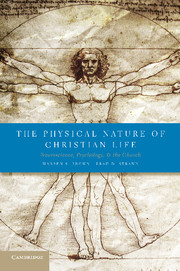Book contents
- Frontmatter
- Contents
- Acknowledgments
- 1 Bodies or Souls?
- Part I Human Nature as Physical
- Part II The Formation of Persons: Retrospect and Prospect
- 4 How Bodies Become Persons
- 5 How Relationships Shape Us
- 6 How We Are Changed and Transformed
- Part III Emodied Christian Life and The Church: Retrospect and Prospect
- Selected Resources
- Index
- References
5 - How Relationships Shape Us
Published online by Cambridge University Press: 05 July 2012
- Frontmatter
- Contents
- Acknowledgments
- 1 Bodies or Souls?
- Part I Human Nature as Physical
- Part II The Formation of Persons: Retrospect and Prospect
- 4 How Bodies Become Persons
- 5 How Relationships Shape Us
- 6 How We Are Changed and Transformed
- Part III Emodied Christian Life and The Church: Retrospect and Prospect
- Selected Resources
- Index
- References
Summary
TRANSFORMATION OF SAUL
Meanwhile Saul was still breathing out murderous threats against the Lord’s disciples. He went to the high priest and asked him for letters to the synagogues in Damascus, so that if he found any there who belonged to the Way, whether men or women, he might take them as prisoners to Jerusalem. As he neared Damascus on his journey, suddenly a light from heaven flashed around him. He fell to the ground and heard a voice say to him, “Saul, Saul, why do you persecute me?”
“Who are you, Lord?” Saul asked.
“I am Jesus, whom you are persecuting,” he replied. “Now get up and go into the city, and you will be told what you must do.”
Saul spent several days with the disciples in Damascus. At once he began to preach in the synagogues that Jesus is the Son of God. All those who heard him were astonished and asked, “Isn’t he the man who raised havoc in Jerusalem among those who call on this name? And hasn’t he come here to take them as prisoners to the chief priests?” Yet Saul grew more and more powerful and baffled the Jews living in Damascus by proving that Jesus is the Messiah.
[Acts 9:1–6; 19–22 NIV]RE-FORMING PERSONS
We are often caused to wonder whether adults can change. Can you teach an old dog new tricks? It is obvious that children change readily. They are adaptable and very open to new learning. The processes involved in the formation of children, and the most significant influences on their development, were the topic of the last chapter. In this chapter, we consider similar processes of change in adults that allow for their continued formation and re-formation.
- Type
- Chapter
- Information
- The Physical Nature of Christian LifeNeuroscience, Psychology, and the Church, pp. 71 - 87Publisher: Cambridge University PressPrint publication year: 2012



